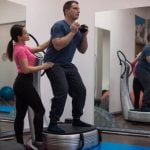Are you looking to enhance your fitness routine with the right gear? Look no further than a fitness gear exercise mat. Whether you are practicing yoga, doing pilates, or engaging in strength training exercises, having the appropriate exercise mat can make a significant difference in your performance and comfort.
Choosing the right exercise mat for your fitness routine is crucial for ensuring safety, support, and stability during your workouts. With a wide variety of options available on the market, understanding the different types of exercise mats and their benefits is essential. From standard foam mats to high-density rubber mats, each type offers unique features that cater to specific workout needs.
When shopping for a fitness gear exercise mat, there are certain key features to consider to ensure you are getting the best option for your needs. Durability, thickness, grip, cushioning, and portability are among the top factors to look out for. Investing in a quality exercise mat that meets these criteria will not only improve your workout experience but also contribute to better results in the long run.
Different Types of Exercise Mats and Their Benefits
When it comes to choosing the right exercise mat for your fitness routine, it’s important to consider the different types available and their specific benefits. One of the most common types is the traditional yoga mat, which provides a non-slip surface for various exercises like yoga, Pilates, and stretching. These mats are lightweight, easy to carry around, and offer cushioning for your joints during floor exercises.
Another popular option is the foam exercise mat, which is thicker and provides more support compared to yoga mats. Foam mats are ideal for high-impact workouts such as HIIT or cardio exercises, as they help reduce strain on your joints while still offering a comfortable surface for movements. These mats are also durable and can withstand intense workouts without slipping or tearing.
For those looking for extra durability and support, rubber exercise mats are a great choice. Rubber mats are often used in commercial gyms due to their ability to absorb impact from heavy weights and equipment. They provide superior traction and stability during weightlifting or bodyweight exercises, making them a versatile option for any fitness enthusiast looking to take their workouts to the next level.
| Type of Exercise Mat | Benefits |
|---|---|
| Yoga Mat | Non-slip surface, lightweight, ideal for yoga and stretching |
| Foam Exercise Mat | Thicker support, ideal for high-impact workouts like HIIT or cardio |
| Rubber Exercise Mat | Durable, absorbs impact from heavy weights, provides superior traction |
Top Features to Look for When Buying a Fitness Gear Exercise Mat
When looking to buy a fitness gear exercise mat, it is crucial to consider certain features that can make a significant difference in your workout experience. The right exercise mat can provide the necessary support and comfort for various exercises while also ensuring safety and durability. Here are some top features to look for when purchasing a fitness gear exercise mat:
Thickness
One of the most important factors to consider when buying an exercise mat is its thickness. The thickness of the mat can impact its cushioning ability and support during exercises. Thicker mats generally provide more comfort and protection for joints, especially during high-impact exercises like jumping or running. However, thicker mats may be less stable for balancing exercises. It is essential to choose the right thickness based on your workout routine and personal preferences.
Material
The material of the exercise mat plays a critical role in its comfort, durability, and grip. Common materials used in exercise mats include PVC, TPE, NBR, and natural rubber. PVC mats are durable and provide good grip but may not be eco-friendly.
TPE mats offer excellent cushioning and are more environmentally friendly than PVC mats. NBR mats are known for their softness and water-resistant properties, making them suitable for yoga or Pilates. Natural rubber mats are sustainable and provide superior grip but may have a rubbery smell initially.
Texture
The texture of the exercise mat can affect its grip during workouts. Mats with a textured surface offer better traction, preventing slips or accidents during exercises that involve movement or sweat. Smooth surfaces may not provide enough grip, especially for those practicing yoga or pilates where stability is crucial. Consider choosing a mat with a non-slip texture to enhance your performance and prevent injuries during workouts.
How to Properly Clean and Maintain Your Exercise Mat for Longevity
Regular cleaning and maintenance of your fitness gear exercise mat is crucial not only for hygiene but also for its longevity. Sweating during workouts can leave your exercise mat dirty and smelly if not properly cleaned. The accumulation of bacteria and germs can also lead to skin irritations or infections. Thus, incorporating a regular cleaning routine will ensure that your exercise mat remains in top condition for years to come.
To clean your exercise mat effectively, start by checking the manufacturer’s instructions on cleaning and care. Most exercise mats can be cleaned with a simple solution of water and gentle soap. You can either spray the solution directly onto the mat or use a damp cloth to wipe it down.
Make sure to thoroughly rinse off any soap residue to prevent slipping during your next workout session. Additionally, allow your exercise mat to air dry completely before rolling it up for storage.
Proper maintenance of your fitness gear exercise mat goes beyond just cleaning. To extend its lifespan, avoid leaving your mat exposed to direct sunlight or extreme heat for prolonged periods as this can cause it to deteriorate faster.
When not in use, store your exercise mat in a cool, dry place away from moisture and humidity. Taking these extra steps in caring for your exercise mat will ensure that it continues to provide you with a comfortable and safe surface for all your workouts.
| Tip | Instructions |
|---|---|
| Check Manufacturer’s Instructions | Always follow the recommended cleaning methods provided by the manufacturer |
| Avoid Direct Sunlight | Store your exercise mat away from direct sunlight or extreme heat to prevent damage |
| Proper Storage | Keep your exercise mat in a cool, dry place when not in use to maintain its quality |
Creative Ways to Incorporate Your Exercise Mat Into Your Workout Routine
Pilates-Inspired Core Workout
One creative way to maximize the use of your fitness gear exercise mat is by incorporating a Pilates-inspired core workout into your routine. This low-impact exercise routine focuses on strengthening your core, improving flexibility, and enhancing overall body alignment. With the support of an exercise mat, you can comfortably perform exercises like the hundred, side leg lifts, and teaser. The cushioning provided by the mat will help protect your spine and joints while engaging in these challenging movements.
Yoga Flow Sequence
Another great way to utilize your exercise mat is by engaging in a yoga flow sequence that incorporates dynamic movements and poses. Whether you are a beginner or an experienced yogi, practicing on a supportive surface can enhance your balance, stability, and mindfulness during each posture. From sun salutations to warrior sequences, having a designated space on your exercise mat can help create a sense of calm and focus as you move through each pose with intention.
3. High-Intensity Interval Training (HIIT) Circuit
For those looking to add some intensity to their workout routine, incorporating a high-intensity interval training (HIIT) circuit on your fitness gear exercise mat can provide an effective full-body workout. With exercises like burpees, mountain climbers, and plank variations, you can challenge your cardiovascular endurance, strength, and agility while minimizing impact on your joints with the cushioned surface of the mat.
By alternating between bursts of high-energy movements and short rest periods on the mat, you can boost your metabolism and burn calories efficiently.
The Best Exercises to Do on a Fitness Gear Exercise Mat
When it comes to maximizing the benefits of your fitness gear exercise mat, choosing the right exercises to do on it is key. The cushioned surface of an exercise mat provides support and comfort, making it ideal for a wide variety of workouts. Here are some of the best exercises you can do on a fitness gear exercise mat to target different muscle groups and improve your overall strength and flexibility:
- Planks: Planks are a great way to engage your core muscles and build stability. By placing your forearms on the mat and holding a straight line from head to heels, you can work your abs, back, and shoulders effectively.
- Push-ups: Performing push-ups on an exercise mat can help reduce strain on your wrists while targeting your chest, triceps, and shoulders. The cushioned surface also provides added comfort during this challenging upper body workout.
- Glute bridges: Lie on your back with your feet hip-width apart and knees bent, then lift your hips towards the ceiling while squeezing your glutes. This exercise is excellent for strengthening the glutes and hamstrings without putting undue pressure on your back.
In addition to these exercises, incorporating yoga poses like downward dog or warrior poses can help improve flexibility and balance on a fitness gear exercise mat. The soft but supportive surface of the mat can enhance stability during these movements, allowing you to focus on proper form and alignment.
Remember to listen to your body and modify any exercises as needed to ensure safety and prevent injury. Whether you’re focusing on strength training, stretching, or yoga, a quality exercise mat is a versatile tool that can elevate your workout routine.
Tips for Storing Your Exercise Mat When Not in Use
When it comes to maintaining the quality and longevity of your fitness gear exercise mat, proper storage is key. By implementing effective storage practices, you can ensure that your exercise mat remains in top condition for a longer period of time.
One of the most important tips for storing your exercise mat when not in use is to roll it up rather than folding it. Rolling your mat helps prevent creases and damage to the material, allowing it to maintain its shape and functionality.
Another helpful tip is to store your fitness gear exercise mat in a cool, dry place away from direct sunlight and moisture. Excessive heat and humidity can cause the mat’s material to deteriorate over time, leading to potential wear and tear. Additionally, storing your exercise mat in a clean environment free from dust and debris can help preserve its cleanliness and hygiene for future workouts.
Lastly, consider investing in a dedicated storage solution for your exercise mat, such as a mat bag or holder. These accessories not only provide convenience in transporting your mat to different workout locations but also offer a designated space for safekeeping when not in use. By following these simple yet effective tips for storing your fitness gear exercise mat, you can enjoy its benefits for years to come while maintaining its quality and performance.
Frequently Asked Questions
What Is the Best Thickness for an Exercise Mat?
The best thickness for an exercise mat depends on personal preference and the type of exercises being done. In general, a thickness between 1/4 inch to 1/2 inch provides a good balance of cushioning and stability for most workouts.
Are Fitness Mats Worth It?
Fitness mats are definitely worth it for anyone who regularly engages in exercises that require floor work, such as yoga, Pilates, or core workouts. They provide cushioning to protect joints, offer traction to prevent slipping, and create a comfortable surface for bodyweight exercises.
What Is the Most Comfortable Exercise Mat?
The most comfortable exercise mat is typically one that is thick enough to provide adequate cushioning without being too soft or unstable. Mats made from high-density foam or rubber tend to offer the best combination of comfort and support for various types of workouts.
It’s important to try out different mats to see what feels best for individual needs and preferences.

Passionate about providing useful information to anyone with an interest in the field of Personal Training, I strive to pass on to our readers quality information and to answer any questions about Personal Trainers, the work they do and how to become one.





